Stargate SG-1 Season 2
Executive producers: Jonathan Glassner & Brad Wright, Michael Greenburg, Richard Dean Anderson
Original air dates: June 26, 1998 – March 12, 1999
Mission briefing. With the help of Bra’tac, SG-1 is able to stop Apophis’s invasion of Earth by destroying both Goa’uld motherships. However, Apophis and Klorel both escape unharmed (which means Skaara is still a Goa’uld). Meanwhile, Jackson returns to Abydos a year after leaving as promised to say that he hasn’t found Sha’re—but Sha’re finds him, and she’s pregnant. Apophis’s host has impregnated Sha’re, and their child is born and kept hidden on Abydos away from Apophis and Amaunet (who are tricked into thinking Heru’ur has him).
Speaking of Heru’ur, he’s one of two new Goa’uld system lords we meet this season, the other being Sokar, both of whom are enemies of Apophis. Jackson tries to convince Heru’ur to ally with Earth against Apophis, but Heru’ur wants to subjugate Earth just as much as all the other bad guys. As for Apophis, he brainwashes Teal’c’s son Ry’ac, and then later is defeated by Sokar and left for dead. Hathor also returns, hoping to use SG-1 to gather intelligence on the other system lords.
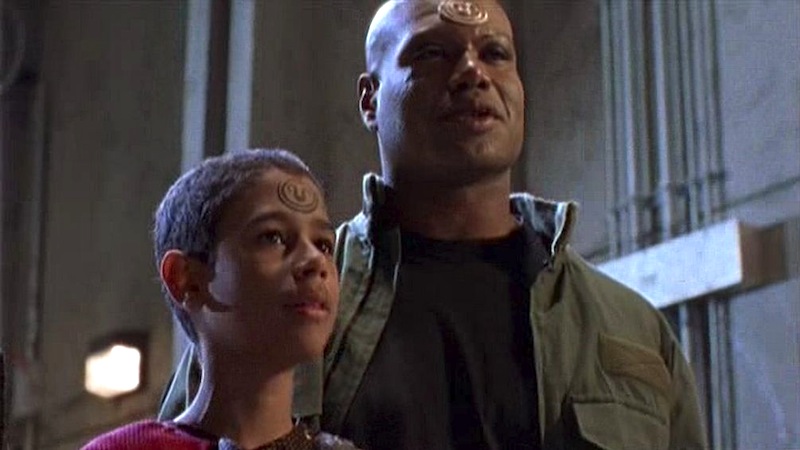
SG-1 deals with several non-Goa’uld threats as well. There’s the Re’tu, who exist out of phase with reality; the A’t’trr Orb that impales O’Neill and infects the SGC with a virus; Linea, a scientist with a horrid past; and an alien bug that infects Teal’c. Plus, the NID is back, and they’re upping their game, including using the second Stargate to run offworld operations, stealing alien technology from allies and enemies alike.
Some aliens are also not quite what they seem. The “spirits” who guide the Salish people seem antagonistic, but turn out to be simply protective. Machello should be an ally of the SGC—he’s been fighting the Goa’uld his whole life—but now that he’s dying, he wants to stay alive and so uses his technology to exchange bodies with Jackson. And the Terellans seem like allies, but they do keep three-fourths of SG-1 as slave labor and keep running Jackson through the sarcophagus until he becomes addicted and deranged.
And sometimes, SG-1 doesn’t have so much a foe to fight as a problem to solve. When SG-10 connects the gate to a world near a black hole, it endangers the entire planet, and a solar flare provides SG-1’s first wacky time travel adventure, as the gate accidentally sends them to 1969, where they meet a very young Lieutenant George Hammond. And a crashed UAV accidentally unleashes a virus.
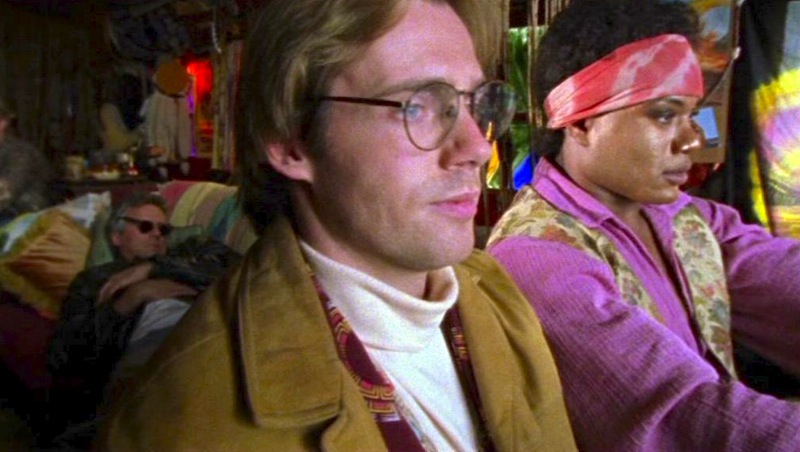
The SGC also makes two critical new allies in this season: a device attaches itself to O’Neill that downloads the language of the Ancients into his brain, and enables him to make contact with the Asgard, finally. In addition, Carter seems to be possessed by a Goa’uld, but it turns out to be a Tok’ra—the same species as the Goa’uld, but they blend with willing hosts and share their bodies rather than suborn them, and fight the system lords covertly. Jolinar of Malkshur sacrifices her life to save Carter’s, and the memories she leaves behind enable SG-1 to track the Tok’ra down. Both the Asgard and the Tok’ra will prove to be valuable allies.
In addition, the SGC gets their hands on more zat’ni’katels (or “zats” as O’Neill prefers) and discover the Gamekeeper’s virtual reality pods, the Ancient repositories, various cool bits of Tok’ra technology, the incredibly hard and dense metal trinium, the Transphasic Eradication Rods that can make invisible things visible, and memory recall devices that can trigger all kinds of flashbacks.
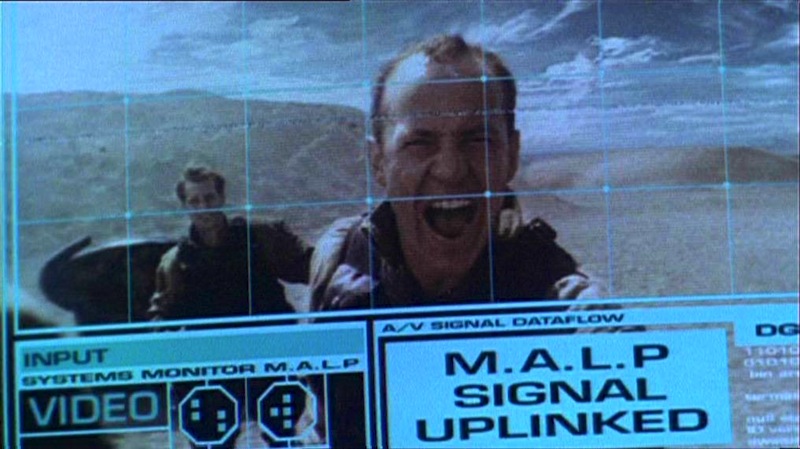
Best episode: “A Matter of Time.” The prototypical SG-1 episode, and the type of story that this franchise does particularly well: a problem-solving storyline that involves a good use of real science (in this case the temporal distortion of the event horizon of a black hole).
Honorable mentions: “The Serpent’s Lair,” an action-packed conclusion to the season-ending cliffhanger, and one that’s worthy of its predecessor (and which came very close to earning the top spot). “In the Line of Duty” and “The Tok’ra” two-parter are also fantastic introductions to an ally that expand the texture of the series in so many ways.
Other strong entries are “The Fifth Race,” a good introduction to the Asgard and a great vehicle for Richard Dean Anderson; “Serpent’s Song,” an equally great vehicle for the underrated Peter Williams as the dying Apophis; “Holiday,” a nice twist on the clichéd body-switching episode, mostly for the revelatory work by Anderson, Michael Shanks, and especially Christopher Judge, whose impersonation of Anderson is stupendous; and “1969,” which is pure cheese, but it’s yummy cheese, and worth it just for the costuming.
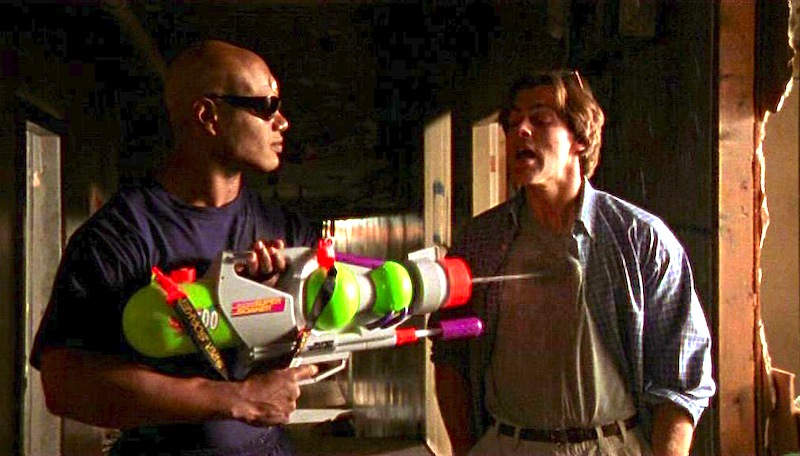
Worst episode: “Bane.” If it weren’t for the final shot of Teal’c hitting Jackson with the squirt gun, this episode would have no redeeming social value whatsoever. As it is, it’s a cliché-ridden mess that is best left forgotten.
Dishonorable mentions: “Spirits,” which has a borderline offensive Native caricature in Rodney A. Grant’s Tonane, and “Out of Mind,” ending the season on an uninteresting clip-show. Where season one’s clip show, “Politics,” actually served a plot function, “Out of Mind” is obvious budget-saving filler.
Can’t we just reverse the polarity? While we do have the cliché of the evil scientist in Linea, we also get plenty of opportunities for Carter to solve problems with science, most notably in “A Matter of Time,” “Message in a Bottle,” “Holiday,” and “1969.”
For cryin’ out loud! O’Neill has divergent reactions to the Asgard and Tok’ra. It helps that the Asgard actually saved him from the Ancient repository that was core-dumped into his brain, while the Tok’ra’s introduction to the team was to, in essence, kidnap Carter. Plus, the Tok’ra are a little too similar to the Goa’uld for O’Neill’s taste.
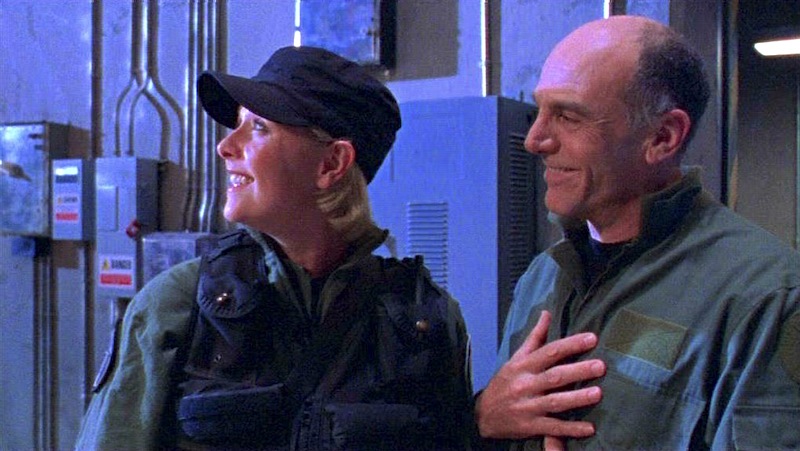
It might work, sir. We meet Carter’s father, and find out he’s dying of lymphoma. However, he blends with a Tok’ra and is cured—not just of the cancer, but also of his arthritis. Carter also continues to feel the aftereffects of her temporary blending with Jolinar, the naquadah in her blood giving her certain abilities and protections, as well as Jolinar’s memories occasionally burbling to the fore.
I speak 23 different languages—pick one. Jackson finally finds Sha’re, and even is able to speak to her directly—because of the pregnancy, Amaunet is subdued, but as soon as the child is born, Amaunet returns to the fore. He tricks Amaunet and hides the child away, but he has yet to be properly reunited with his wife.
We also learn that Jackson’s parents died in an accident in a museum when he was very young.
Indeed. Teal’c’s family is used against him, as Ry’ac is brainwashed into trying to destroy Earth for Apophis. (Apophis will later use this technique on Teal’c himself.) He also gets infected by an alien bug.
You have a go. We find out that Hammond actually first met SG-1 in 1969 as a lieutenant, and you wonder how much that long-ago meeting has affected his actions—not to mention his confidence in SG-1’s ability to survive certain death at times like in “The Serpent’s Lair.”
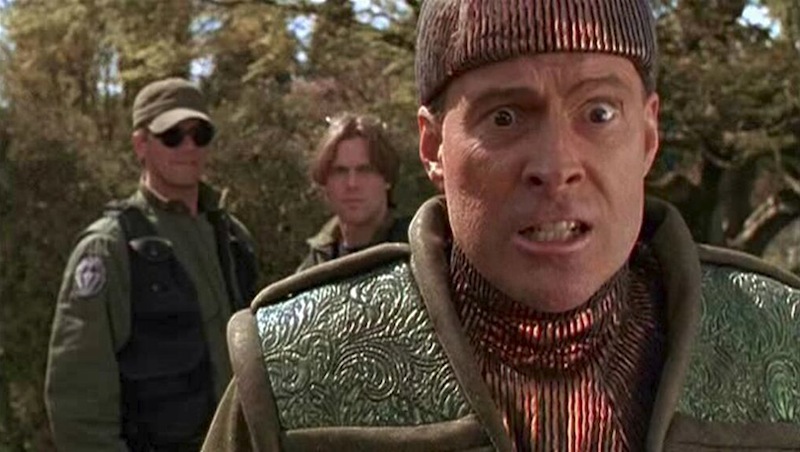
Wayward home for out-of-work genre actors. Dwight Schultz, best known as Murdock in The A-Team and Barclay in the various Star Trek spinoffs, shows up as the titular character in “The Gamekeeper.” Sarah Douglas, best known as Ursa in Superman and Superman II, plays Garshaw in “The Tok’ra” two-parter. Also Michael Shanks does double duty as Machello in “Holiday.”
Trivial matters. Erick Avari reappears as Kasuf in “Secrets,” reprising the role from Stargate; along with Alexis Cruz as Skaara, he is the only actor to play the same role in both film and series.
Hathor, Apophis, Klorel, and the NID (and the antagonistic Colonel Harry Maybourne, played by Tom McBeath) all return as bad guys. Recurring characters Jacob Carter, Martouf/Lantash, and Heru’ur are all introduced (as is Sokar, though we never see him). We get the final appearance of Samuels in this timeline, though an alternate timeline version of him will return in “Moebius.”
Richard Dean Anderson won a Saturn Award for Best Genre TV Actor for his work in this season.
The effects of a sarcophagus on a healthy person are seen in “Need,” which goes a long way toward explaining why the Goa’uld are nuts. (Tellingly, the Tok’ra never use sarcophagi.)
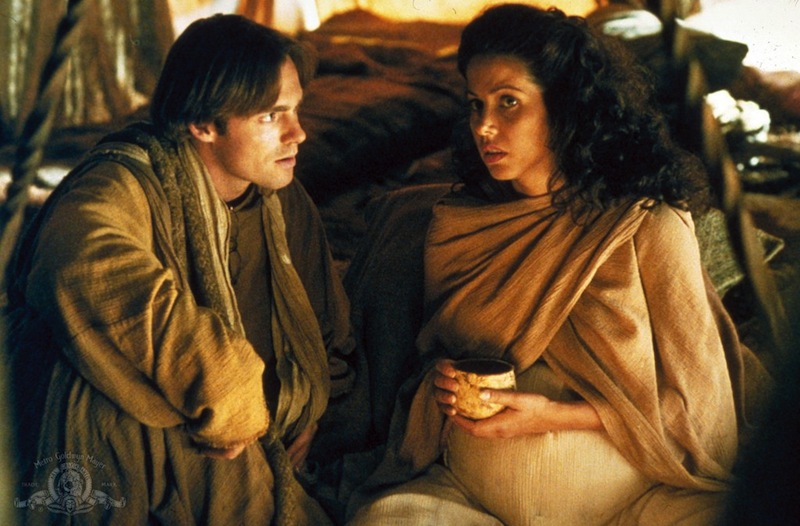
Vaitiare Bandera was actually pregnant when “Secrets” was shot, so Sha’re’s pregnancy was very realistic. During the labor scene, Michael Shanks (who was the father of the kid) kept joking between takes, “Don’t come yet, baby!”
Colleen Rennison, who plays Allyson in “Bane,” will later take over the role of Cassandra. In this season (and the first), Cassandra is played by Katie Stuart (and also Pamela Perry appears as the Cassandra of 2089 in “1969”).
Teryl Rothery establishes herself pretty firmly as a recurring regular, as she’s the only person not in the opening credits to appear in more than half the season’s episodes as Dr. Janet Fraiser.
Chevron seven locked. While the first season introduced a whole bunch of things, the second season settled down and really started to expand the universe. Besides giving us two more Goa’uld in Her’ur and Sokar, we also meet the Tok’ra, a Fifth Column of Goa’uld offshoots who are also fighting the bad guys. In addition, we get Carter’s father, Jacob, who becomes a Tok’ra, cementing the alliance and giving us a most excellent recurring actor in Carmen Argenziano.
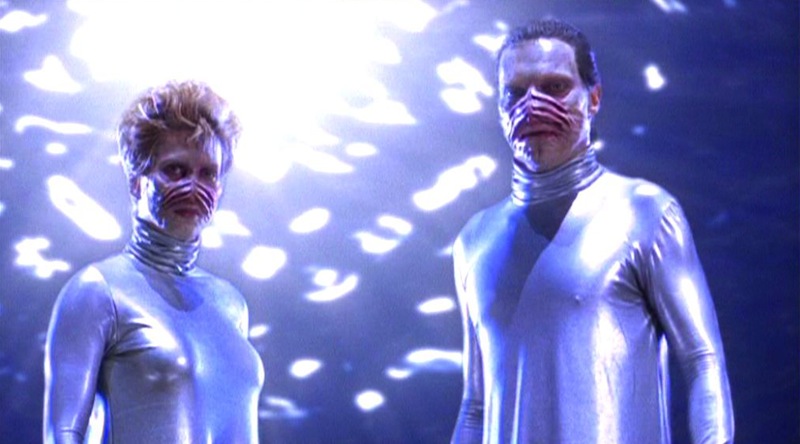
They tried to introduce a whole bunch of different alien threats—the aliens in “Spirits,” the Re’tu in “Show and Tell,” the bug in “Bane,” the orb in “Message in a Bottle”—but none of them were as compelling as the Goa’uld. Part of that is the fact that those other threats can be found on any show—they none of them would be out of place on Star Trek or The Outer Limits. But the Goa’uld (and the other characters that grow out of the war with them, like the Jaffa, the Tok’ra, Machello, etc.) are uniquely Stargate, with the aggressive tie between Earth mythology and alien culture. Even the Asgard are a wonderfully Stargate-ish twist on the “grays” of UFO lore.
More and more it becomes clear that the show’s bread and butter are shows that either focus on the war against the Goa’uld or shows that specifically show the consequences (good and bad) of travelling through the Stargate (like “A Matter of Time”).
The writers also let the actors stretch some more. Amanda Tapping gets to play a second role, as Jolinar, in “In the Line of Duty,” and the other three get to imitate each other (and in Michael Shanks’s case, play a second role) in “Holiday.” Peter Williams and Vaitiare Bandera both get more to chew on than usual in, respectively, “The Serpent’s Song” and “Secrets.” And Tom McBeath gets the chance to show that there’s more to Maybourne than a nasty bureaucrat—that character will develop into one of the show’s stronger antagonists, and it’s all due to the verve McBeath brings to the role.
There’s nothing that stands out about this second season, none of these episodes will ever be listed among SG-1’s best. But aside from “Bane,” there’s nothing actively offensive here. It’s a solid season of episodes from a show that has wasted little time in finding its footing.
Keith R.A. DeCandido is hard at work on Kali’s Wrath, an SG-1 novel taking place in the fifth season. His Carter-and-Teal’c story “Time Keeps on Slippin’” can be seen in the anthology Far Horizons.











ALL the apostrophes!! Also, nice choice by TorChris on the picture from “1969” – gotta love hippie Teal’c. Fantastic cheese indeed.
Hmm, somehow I never noticed before that both TNG and SG1 ended their second seasons with shitty clip shows. A cautionary tale for other genre shows in their second season, perhaps – spend properly so you don’t end up like these guys!
But you know, I can’t find any evidence of people actually dying in accidents in museums. Now that I think about it, museums are pretty darn safe, unless you break off part of King Tut, in which case the curator will kill you.
Also, can we please hurry along to the seasons where Michael Shanks’s hair isn’t terrible? I’m dyin’, here.
Spirits is a giant cliche’ filled episode but I think it’s the first time Alex Zahara shows up as a guest alien. He plays various ones about 8 different times during the run of the show. Bane is annoying I just remember it for Scott Hyland and the super soakers. Should we have a seprate section for Canandian genre actors whos face I know but real name I have to look up? Your right 1969 is some fun yummy cheese. I honestly forgot what the finale was for this season especially after the awsomeness of one’s.
1969 may not be the ‘best’ episode, but it’s one of the ones I go back to if I want to enjoy the show. Also, I’m not sure that ‘A matter of time’ isn’t one of the top 10 episodes (top 15 for sure).
I don’t dislike Tonane’s carácter that much. A pretty relaxed guy that dealt with the end of his religion very matter of factly. What was weird in that episode was the way Hammond and the rest were acting, basically not caring about the aliens wishes and committing the same mistakes that were made with RL native americans. Seemed out of carácter to me.
I think “Bane” probably wins the award for worst episode of the entire franchise.
I was surprised you picked “A Matter of Time” as the best, but it wouldn’t be the first time we disagreed. Different tastes I guess. And speaking of those tastes, I think I wouldn’t hesitate to nominate “The Fifth Race” and “Secrets” as being in the running for best episodes, but that maybe depends on how many slots we get.
I’m still not sure how I feel about “1969.” It’s a fun episode and I enjoy watching it. But, aside from opening the time-travel door and thus subjecting us to a bunch of paradoxes, I’m uncomfortable with the assertions that this was all in the back of Hammond’s mind all this time, and that also in the future the Stargate is collecting dust in an abandoned Cheyenne Mountain complex. On the other hand, it did pave the way for “2010”, which is also one of my favorite episodes.
The first SG-1 episode I ever saw was “One False Step” from this season. I wasn’t overly impressed by it, I think, since I didn’t start watching regularly until the end of season 3 or the start of S4. On later viewings, I became convinced that it was written with the intention of the aliens being far more exotic and nonhuman in appearance, but budget limitations must’ve forced them to go with actors in rather simple makeup, and it clashed hugely with the story, since it required them to be so profoundly inhuman. Plus it couldn’t really fit into the series’ established backstory about the origin of human/humanoid aliens.
Revisiting the season later on, I found it to have a lot of strong episodes; I pretty much agree with Keith’s listing, although I think I would’ve ranked “Serpent’s Song” higher. And I’d probably rate “Holiday” rather low if it weren’t for the brilliance of the actors playing each other’s characters.
I have mixed feelings about the Asgard. “Gray” aliens are one of the lamest cliches around, so I wasn’t happy to see them used here (also, why don’t they wear clothes?). Also, it’s worth noting that the Asgard were created by Katharyn Powers, the same writer responsible for the dreadful “Emancipation” (although Robert C. Cooper wrote “The Fifth Race,” so he may have been responsible for making them Grays). But on the other hand, the series did an impressive job with the animatronic and CGI effects for the Asgard, and it’s always nice to see aliens that are creature effects instead of actors in makeup. Plus, Thor was awesome.
Oh, speaking of actors doing double duty, Keith, you forgot to mention that Michael Shanks also did the voice of Thor. Which meant he often ended up having dialogue scenes with himself.
As for “1969,” it’s a fun episode, but my problem is that it cheats to set up the situation. Every other time we see characters time travel through the Stargate, they emerge through the Stargate at wherever it is at the particular time they arrive, which is only sensible. But since “1969” was about the characters needing to find the Stargate, it was predicated on the implausible premise that they emerged where the Stargate would be 30 years later rather than where it actually was at the time. Having them emerge in the Gate Room and then seeing it transform around them into a rocket silo was silly and fanciful, and it’s always bugged me, even though the rest of the episode is fun.
@1/MeredithP: ST:TNG actually agreed to do a clip show so that they could spend more money on “Q Who” (the first Borg episode) and one other. It was a deliberate tradeoff rather than the result of lack of planning. And as I mentioned last week, clip shows were such a regular annual feature of series like SG-1 and Showtime’s Outer Limits that I suspect they were intentionally planned for from the start.
While it’s not perfect, “Touchstone” is a favorite of mine since that’s the beginning of the NID conspiracy that’ll become a headache for the SGC for the remainder of the show (and take a karmic, if horribly ironic turn in Season 8).
I think I would have to agree that “The Fifth Race” would have been my pick of the cream of this season. What stands out the most for me is how much of what was great in later seasons was built this year: “Maternal Instinct” and “Absolute Power” both flow from and follow from “Secrets,” which also generated the idea for the Ancients, which were probably not as well thought when S1 or even S2 were being story boarded. As Keith stated, this season also gave us the Asgard and the Tok’ra – and as CLB notes, Shanks also did the voice for Thor!
“1969” on first viewing, reminded me a great deal of a certain whale movie, down to the fact that the alien member of the team had to wear specific head gear to disguise a non-humanoid aspect above-the-neck but yeah, it was a fun episode. In addition to being a good role for Peter Williams, “Serpent’s Song” also helped make the villains less one-dimensional and I’d vote it higher.
Jolinar of Malkshur sacrifices her life to save Carter’s.
Jolinar did have a preference for female hosts, but I think only queens are female goa’ulds. So do we consider that goa’ulds have a concept of gender, but which is unrelated to their sex?
Goa’uld queens are rare, and exclusively use women (is it stated anywhere that they can’t have male hosts?). On the other hand, not many goa’ulds use women as hosts.
If we consider that gender applies to goa’ulds, Amaunet and Jolinar are definitely women. Same for Bastet, with her female jaffas. We don’t know much about the choice of hosts for Amaterasu, Kali, Nirrti, Qetesh, and maybe a few others (as I said, not many goa’ulds choose female hosts).
Then there are goa’ulds whose choices of hosts were clearly oportunistic, like Osiris, Athena and the one for Kianna Cyr. Interestingly, Osiris is a god in Egyptian mythology, which suggests a male host originally, so Osiris could have released Anna-Louise Plowman for another host, but didn’t: this shows that sex is not a strong factor in the choice of host for some goa’ulds, and raises the question of why so many choose male hosts.
“A Matter Of Time” is one of my favorite Stargate SG-1 episodes of all time because it used real science to craft a compelling thriller with a sense of genuine threat. I remember the first time I watched that I said out loud “Someone worked out the math.” I’m sure it was just a quick calculation on a page of a notebook and there was some fudging for episode purposes, but I’ve still never seen black hole physics handled in such a scientifically mindful way in any other film or television series.
@9/Athereen: Goa’uld tend to be referred to by the gender of their host at the time, hence “she” for Jolinar. I don’t think it’s meant to refer to the symbiote independently of the host. (SG used the “symbiote” form of the word, right? Strictly speaking, the correct form is “symbiont,” which is the version Star Trek used for the Trill. “Symbiote” was coined in error by Hal Clement in his 1950 novel Needle, but since Clement was such a prominent writer, the term caught on more widely in SF. I believe Marvel Comics also uses it for the Venom and Carnage symbiotes.)
Here’s the Stargate Wiki’s list of known Goa’uld. Sticking just to canonical ones, I count 44 who used male personas and 14 who used female ones — and three who either switched genders or expressed a willingness to do so, namely Osiris, Ba’al, and Adrian Conrad’s Goa’uld. That is a more extreme gender imbalance than I thought.
Still, most Goa’uld based their power on the Earth mythological personas they adopted, and most classical Earth cultures tended to ascribe more power and dominance to their male deities than their female ones. Presumably most Goa’uld would prefer hosts of the same sex as their chosen deity, in order to keep up the illusion that they relied upon for the obedience and worship of their human slaves.
Christopher: I didn’t mention Michael Shanks doing the voice of Thor because he didn’t do the voice of Thor in the second season. Mark Gibbon provided the voice in “Thor’s Chariot.” Shanks won’t start providing Thor’s voice until “Fair Game” in the third season.
—Keith R.A. DeCandido
@12/krad: Oh, I see.
I wonder why so many nonhumanoid aliens in fiction — the Asgard/Grays being just one example — are portrayed as nude. Maybe it’s because we tend to lump them into the same category as the nonhumans we’re familiar with, i.e. animals. But it’s still odd. I mean, I can certainly understand aliens not sharing our taboos about exposing certain parts of the body, but clothing can have practical value, like providing warmth, protection, and best of all, pockets. I still remember an episode where Thor gave a human character a device that just sort of magically appeared in his hand between shots, and I had to wonder where the hell he was keeping it. (I don’t remember if O’Neill or someone actually lampshaded that very question. It’s the sort of thing the show would do. I know that both Sheppard and Mitchell questioned the Asgard’s nudity when they first met them, but I don’t know if the pocket issue came up.)
Sad that we never met the Furlings (I’m not counting episode 200 in this comment) for certain. Loving this reread!
“A Matter of Time” is one of the greatest hours of TV ever, and I’ll tell you why.
1. The story uses real science, but cleverly gives a reason for any mistakes. It’s not just an episode about a black hole, it’s an episode about how a black hole interacts with a stargate.
2. The slo-mo, while normally a kind of silly effect, comes across as pretty scary. The director commits to it, and it never feels like a gimmick.
3. It makes an outgoing wormhole scary. I love the different behaviors the show uses for outgoing and incoming wormholes. Outgoing, they stand around talking, maybe send a MALP, maybe use the radio, certain in their safety. Incoming, the guys with guns are at the ramp, the alarms are blaring, no one knows if THIS TIME will be when the Goa’uld crack the GDO codes and an army of Jaffa is coming through… or a giant bomb. In this episode you see the horror as they realize that they may have just killed the planet doing the one thing the stargate does that they thought was totally safe. (In The Exorcist, they do something similar. When they go to the kid’s room, you know it will be horrible. When they go back downstairs, it is safe for a bit. And then the kid COMES DOWN THE STAIRS. Gah!)
4. Carter doesn’t solve it by first principles. It isn’t “My theory of wormhole mechanics indicates…”, it’s “We know an explosion can cause the gate to jump addresses, let’s try that before we bury it.” There’s that famous quote, “Never apply a Star Trek solution to a Babylon 5 problem.” This episode shows the Stargate SG1 solution: there’s very few problems that can’t be solved by enough explosives.
5. They use it again. Hey, a free portal to a black hole can come in handy…
The only bad thing in the episode is the ending to the subplot with the other colonel. He dies a pretty awful death, and no one mentions him in the final scene! It’s a huge redshirt moment, for a show that normally doesn’t do that sort of thing.
In other news, I love the way they sell the absolute arrogance of the Goa’uld. Apophis is such a great bad guy, always so sure that these buzzing little gnats from Earth are just moments away from being swatted… if they would just stop DOING stuff.
By the way, I’ve always been a little bothered by what a ruthless defense mechanism the Stargate iris is. I mean, anyone who tries to come through gets disintegrated. There’s even an episode — I think it’s next season — where some peaceful emissaries are killed by the iris before communication is established. I wish they could’ve come up with a better way to “lock the door,” one that didn’t kill anyone who tried to come through.
Another thing that bugged me was the lack of any kind of quarantine or decontamination procedure. Ideally, the Stargate should’ve been in a quarantine vault and anyone or anything coming out of it should’ve gone through a thorough decontamination and exam before being let out. That would’ve slowed down a lot of the drama, but Star Trek: Enterprise managed to pull it off (leaving aside the gratuitous titillation component thereof).
Granted, I suppose you could say that burying the SGC under Cheyenne Mountain was a pretty effective quarantine in itself, but that setup still endangers the entire SGC staff if an alien virus or something gets through. And we did see the occasional alien virus or insect or what-have-you get out into the outside world.
Here’s an idea they could’ve tried: Install the backup Stargate in an automated facility on the Moon. Set it up so anyone dialing in to Earth arrives there. Then have them go through security and medical checks. If they’re cleared, then remotely dial the gate and let them come to Earth. If not, if the people who come through are bad guys, dial the gate to some distant world and shut off life support so they have no choice but to leave. Heck, maybe put the whole SGC on the Moon or a space station, so that Earth isn’t endangered if something dangerous — like a black hole’s gravity warp — does get through the gate.
The iris is the worst thing about SG1. It’s a Earth-made device that closes to within an angstrom of the event horizon of the wormhole? Holy cow. I’m not even going to mention that they apparently manufactured it within the timeframe of “Children of the Gods”. And why doesn’t it vaporize in the kawoosh? (Besides a desire to save on VFX costs, of course).
Is there a book or body of knowledge for SG1 equivalent to the DS9 Companion or JMS’s forum posts? The writers are too good not to notice these things, so I’d love to hear about when they made the “don’t think about it too hard” call for the iris.
There are actually a butt-load (to use the scientific term) of Egyptian dieties and a great number of them have female personifications – in fact, the show did not even use some of the more well-known (such as Maat) and Isis was presumably killed off-camera in the fourth season. The show didn’t use some of these, and some (as I said previously, such as Hathor) were used poorly in comparison to say Heru’ur, who existed beyond a few episodes; Basat is a perfect example of a potentially important and interesting diety who was summarily dismissed in one episode, and essentially as part of background chorus role.
They also created roles, such as Hu, without really creating comparable roles (compare Hu with say Kali) once they went outside Egyptian mythology. Ishtar is an important diety they omitted as well, given her counterparts, plus the story of Gilgamesh.
@17/Brian: Remember, in the movie, Ra was prevented from coming to Earth because the rebels buried the Stargate. In the early seasons, you see SG-1 advising a number of worlds to bury their gates as well. It’s just part of how the Stargate works that it can’t establish a wormhole if there’s something blocking the egress.
True, the iris does allow the gate to form, but the show explained that the same process that prevented matter from reassembling in the gap between the horizon and the iris also prevented the formation of the unstable vortex (the “kawoosh”), because there just isn’t enough room for it to get going. In other words, the vortex isn’t an intrinsic property of the wormhole, but something it triggers at the point of arrival.
So yeah, there are a lot of technical contrivances in the show, but over time, the writing staff did a great job coming up with plausible-sounding explanations for most of it. (With some exceptions that we’ll probably get to in the weeks ahead.)
As for a book of knowledge, all I can suggest are sites like the Stargate Wiki and Gateworld. There’s also The Truth Behind Stargate, which compares the stuff from the shows against real history, mythology, science, etc.
@19/FDS: I can’t find anything in the SG Wiki about a Hu. Do you mean Lord Yu? He’s based on one or both of two figures from Chinese legend, Yu the Great (legendary founder of dynastic rule in China) and the Jade Emperor, the supreme being in Taoist theology. Since he’s a millennia-old Goa’uld, he could’ve been associated with both figures in different eras, explaining why he was identified with both over the course of the show.
Do we ever see what happens to incoming travellers when they hit the Ancient’s forcefield that they used on Atlantis? I can see SGC going with the quick and dirty solution of the iris, but you’d think the Ancients would come up with something less final. It’s good to have correctable mistakes.
@21: Apparently the Atlantis force field is just as terminal for incoming travelers, according to the Wiki.
Yeah, Sheppard use it to kill a whole platoon of Genni goons during Season 01.
@21: Given some of the things we learn about the Ancients during Atlantis, I wouldn’t necessarily be surprised if they didn’t care about it being lethal, especially if it was installed after the war with the Wraith had started.
@16 CLB: I wanna say the episode is the one with Rene Auberjonois, which would be at the beginning of season 4, but I could be very mistaken. Now I find my memory a little fuzzy
@6 CLB: Didn’t mention it, but the appearing in the gateroom thing is one of the things that bothers me too. The thing is, since they were captured by and escaped the military in the first place, they could’ve easily had them be captured in the warehouse or close to, and then had them trying to find out where the gate was being moved to–though I suppose that means it would’ve been more heavily guarded at the end.
In regards to the male/female Goa’uld discussion–I think it is established that they are usually referred to by the sex of the host…do we know that much about the sex of the symbiotes and how they reproduce? Since the breeding type is called a queen, I immediately think of insects, and from what I know of such they don’t necessarily conform to the binary sex paradigm that humans have. So I don’t know what you would consider non-queen symbiotes to be. Also, there’s the bothersome line in “Hathor” that she needs to “acquire the code” from a human first…or the fact that they later establish that a queen is super engorged while pregnant, so how could Hathor stay in the host while spawning and she’s just chilling in the tub?
@24/crzydroid: Yup, I think it’s the one with Auberjonois, but I didn’t remember whether that was season 3 or 4.
As for “Hathor,” I try not to think about that episode much, and I think the same went for the producers.
@6/Christopher – Hmm, okay, that’s fair. I still find it a bit silly to make it your closer for the season. Even if you’re not doing a cliffhanger, go out strong so people will be excited for the next season. JMHO.
Maaan… now I want to watch this show again even more, but my son and I are already watching TNG (season 7 finishing soon) and DS9 (season 2); and then there’s VOY… I wonder if when we finish TNG we should slip in SG1…
Goa’uld reproduction involves a queen (besides Hathor we’ll see later an episode with the Tok’ra queen). But it seems most Goa’ulds are either males, genderless or genderless assuming the gender of the first human host, but not necessarily so (like Osiris).
http://www.stargate-sg1-solutions.com/wiki/Symbiote_Reproduction
Apophis and Amaunet were able to reproduce using their hosts, creating a harsesis, something very taboo in their culture.
http://www.stargate-sg1-solutions.com/wiki/Harsesis
I don’t know if most goa’uld couples are actually made of female and male goa’uld, able to reproduce. Apparently Apophis and Amaunet were, since we saw a lot of young goa’uld that were intended to be put into Jaffa lying about (SG-1 destroyed one of acquarium full of them). Klorel was the offspring of Apophis and a goa’uld queen, but not Amaunet.
Other couples, like Martouf and Jolinar, assumed the genders of their hosts, but were not able to reproduce, and sticked to a speficic gender only due to their preference. Jolinar was in a male before she invaded Carter’s body, but she preferred to be inside female hosts. Selmak was in a woman before it entered Jacob Carter.
Speaking of Selmak, one thing that bugged me about the show was that season 2 set up the premise of the Tok’ra recruiting terminally ill human hosts, saving their lives in exchange for consensual symbiosis. The SGC said they’d consider it, and Jacob was a very successful test case, but then we never heard it mentioned again, even though the Tok’ra were supposed to be desperately in need of a new supply of hosts. I wish that thread hadn’t just been forgotten about.
@29: Hmm…I could’ve sworn I remembered an episode in one of the later seasons where the Tok’ra call out the SGC on this, when the ties of the alliance are fraying. I’ll definitely have to try and fit in a rewatch and see.
crzydroid: Actually, that was never mentioned in “Death Knell,” the episode that ended the Tau’ri/Tok’ra alliance, except insofar as Delek thought that Selmak was being too heavily influenced by Jacob. The impression it gave was that, in fact, the Tok’ra had not taken any other Earth-based hosts.
—Keith R.A. DeCandido
@29,30
I agree with crzydroid.
From gateworld’s analysis of season 4’s episode, Crossroads
Earth’s changing relationship with the Tok’ra is ironic. The alliance originally came about because Earth could offer potential hosts — terminally ill patients who could be healed by a Tok’ra symbiote (“The Tok’ra, Part 2”). Now, it is the Tok’ra who manage to secure a host for a symbiote brought by the S.G.C. If the Tok’ra can secure their own, willing hosts, what do they really need with Earth? This may be one factor behind the strained relationship between the two groups.
http://www.gateworld.net/sg1/s4/404.shtml
@32/Ryamano: But that just underlines the problem. The writers initially set up a situation where the Tok’ra needed hosts from Earth, and then they forgot that and did a story where the Tok’ra could provide a host on demand. You can rationalize it after the fact, sure, but that doesn’t mean the writers didn’t lose the thread and overlook some story possibilities.
They did forget to use that plot point, but if they had used it, I bet they’d say SGC was unwilling to reveal the Stargate Program and Everything Out There to any more humans than were necessary.
The ironic thing is Adrian Conrad, who wanted to procure a symbiote for the specific reason of curing his disease. Now, granted, you maybe could make some assumptions about his character and say he was not the type who would be willing to give his life in service to the Tok’ra in exchange for saving it.
CLB (#19), yes my bad, I haven’t actually been re-watching any of these (although episodes do pop up on one of the syndication VHF stations locally and I’ll occassionally catch a brief part of one) – I was remembering how Yu’s name was pronounced, without looking him up.
What I meant is that he (Yu) was a created diety (albeit there’s again a B-L of history showing us that rulers often claimed a divine right or actual status as a diety to rule); such that pre the 9th season of the show, a great deal was made in pre-press/pre-production and blogs, etc. coverage that the show was going to use an actual Shinto god (and in this case a female one), Amaterasu, and some of that coverage noted that Yu was never actually represented as the Jade Emperor, just allowed to be implied (and the show never negated these points otherwise). Also, at that time frame (I recall all this because this is not a new argument, it came up in GateWorld and other sites I frequented contemporaneously with watching the last few seasons of the series), it was just assumed that the rolel was an attempt to make the show appear more diverse, excepting (as I was trying to state, that roles such as Kali or Amaterasu) played minimally in the mythology or the on-going plotting of the actual episodes.
The Asgard were valuable allies. The Tok’ra were mostly annoying , obstructive and patronizing.